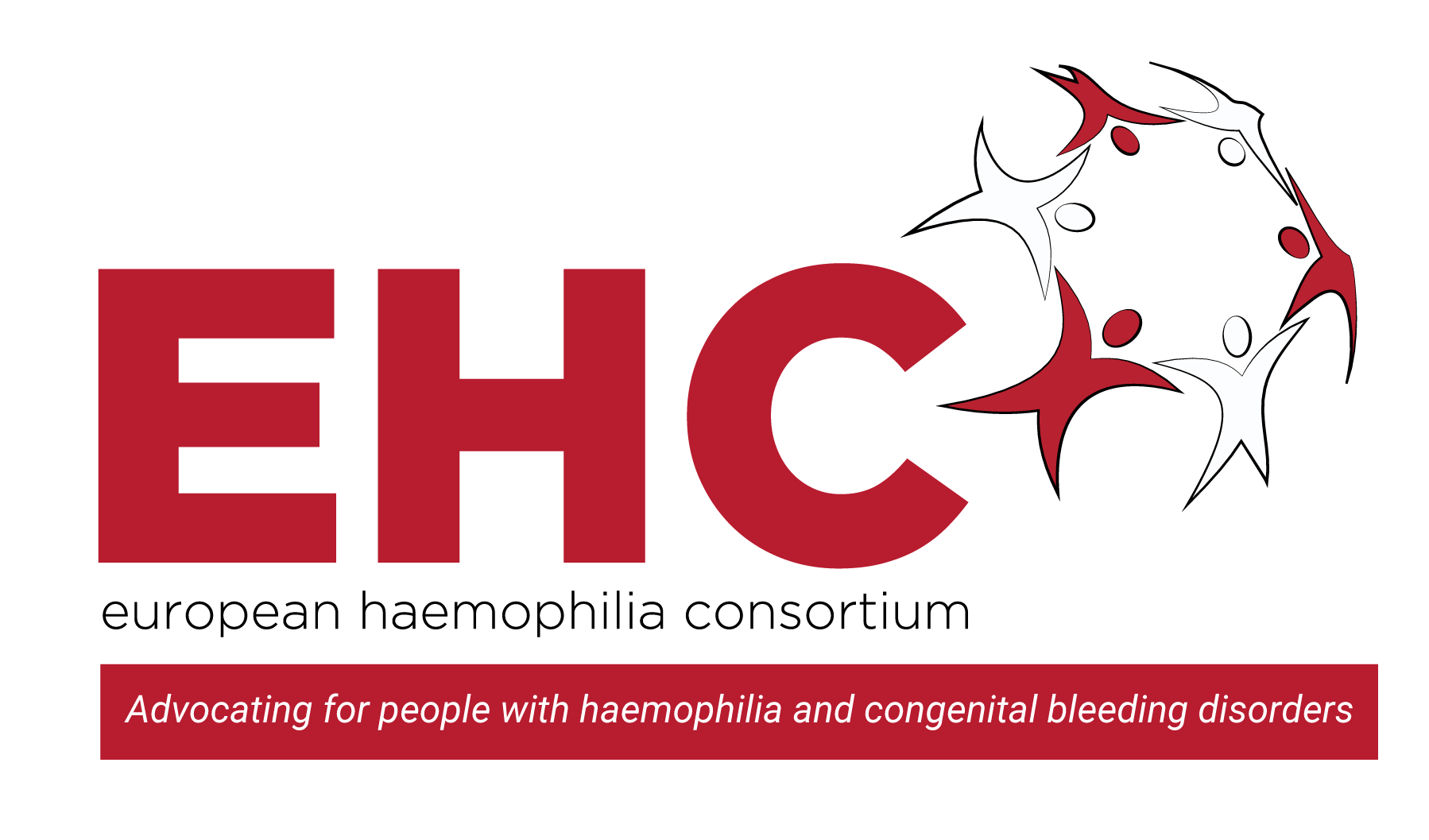In this section we will briefly explain:
- What are bleeding disorders
- The clotting process
- How coagulation affects an individual
- Different types of bleeding disorders
‘Bleeding disorders’ is a generic name for a group of disorders that affect the ability of blood to clot in an individual. Bleeding disorders include conditions such as haemophilia A and haemophilia B, von Willebrand Disease (VWD) and rare bleeding disorders (RBDs). These conditions present themselves in either severe, moderate or mild form.
When they have access to adequate treatment, people with bleeding disorders are able to lead normal and fruitful lives. However, poor access to treatment can have drastic consequences on the lives of those affected by these conditions. In fact, bleeds that are not properly managed can be crippling and even life-threatening when they occur for example in the brain.
All bleeding disorders fit the description of rare diseases as provided by the European Union, which is a condition that affects less than 5 people in 10,000 (See the table below). Despite being rare diseases, conditions such as haemophilia and von Willebrand Disease (the most frequent bleeding disorders) are actually ahead of the curve compared to many other rare diseases, in the sense that both diagnostics and a variety of treatments exist for these conditions. The challenges faced by these patients relate to a lack of access to adequate treatment (which is often expensive) and specialised healthcare services (which may be located only in one or two cities in a given country).
Furthermore, patients within the European region face great disparities in access to treatment and, as a result, have different qualities of life. The EHC strives both at the European and national levels to increase the awareness of the daily realities of people with bleeding disorders .
This section provides a short overview of what these conditions are and how they affect people with bleeding disorders. If you are a patient with a bleeding disorder and you are looking for more in-depth medical information, we recommend the following websites:
- The website of your national haemophilia association
- The website of the World Federation of Hemophilia
- The website of Haemophilia Central
- Orpha.net
The Clotting Process
Clotting factors are proteins in the blood that control bleeding. When a blood vessel is injured, the walls of the blood vessel contract to limit the flow of blood to the damaged area. Then, small blood cells called platelets stick to the site of the injury and spread along the surface of the blood vessel to stop the bleeding.
At the same time, chemical signals are released from small sacs inside the platelets that attract other cells to the area and make them clump together to form what is called a platelet plug.
On the surface of these activated platelets, many different clotting factors work together in a series of complex chemical reactions (known as the coagulation cascade) to form a fibrin clot. The clot acts like a mesh to stop the bleeding.
Coagulation factors circulate in the blood in an inactive form. When a blood vessel is injured, the coagulation cascade is initiated and each coagulation factor is activated in a specific order to lead to the formation of the blood clot. Coagulation factors are identified with Roman numerals (e.g. factor I or FI) although the coagulation cascade does not follow numerical sequencing.
For a graphic representation of the coagulation cascade please view the video below:
How coagulation disorders affect an individual
One of the main impacts of bleeding disorders on an individual is the damage to joints such as hips, knees, wrists, ankles and shoulders. Joints are part of the body with a high number of blood vessels. They are therefore more at risk of bleeds. When a bleed occurs in the joint, the synovium (which is part of the joint) absorbs the blood in an attempt to remove it. The iron in the blood accumulates in the synovium. Doctors think the iron causes the synovial lining to get thicker. The thicker the synovium is, the more blood vessels it contains. This, in turn, makes subsequent bleeding more likely. This results in similar effects as people suffering from arthritis. The more bleeds an individual experiences, the more damage is done to the joint. This can lead to joint destruction, leaving the affected individual with very little to no movement range. Besides causing disability, joint bleeds are extremely painful and if not properly managed can take up to several weeks to recover. This can increase days of hospital stay and not being able to take part in any study, work or social activity. This is why it is recommended to prevent joint bleeds instead of treating them.
At the moment it is believed that prophylactic treatment is the best solution to prevent joint bleeds. Unfortunately, this is often seen as an expensive course of action. However, the EHC believes that investing in the prevention of joint bleeds is the optimal course of treatment. In fact, once a joint bleed occurs, the affected individual may receive a high amounts of coagulation factor to stop the bleed and, at the end of the year, this amount of factor may be comparable to treatment levels the individual would have received, had prophylaxis been followed.
For more information on joint damage, we invite you to consult the website of the Canadian Haemophilia Society, which has a comprehensive description of this phenomenon.
Different types of bleeding disorders
The type of bleeding disorder affecting an individual depends on the type of coagulation factor or platelet that is low or malfunctioning. Below is a table showing the various bleeding disorders:
Affected factor |
Name of the disorder |
Estimated Prevalence (source Orpha.net) |
|
Factor I (1) |
Factor I or Fibrinogen Deficiency |
1/ 1,000,000 |
|
Factor II (2) |
Factor II or Prothrombin Deficiency |
1/ 2,000,000 |
|
Factor V (5) |
Factor V Deficiency |
1/ 1,000,000 |
|
Factor V (5) + Factor VIII (8) |
Combined Factor V and Factor VIII Deficiency |
Between 1/ 100,000 and 1/ 1,000,000 |
|
Factor VII (7) |
Factor VII Deficiency |
1/ 300,000 |
|
Factor VIII (8) |
Haemophilia A |
1/ 6,000 |
|
Factor IX (9) |
Haemophilia B |
1/ 30,000 |
|
Factor X (10) |
Factor X Deficiency |
1/ 500,000 |
|
Factor XI (11) |
Factor XI Deficiency |
1/ 1,000,000 |
|
Factor XIII (13) |
Factor XIII Deficiency |
1/ 2,000,000 |
|
Von Willebrand Factor |
Von Willebrand Disease |
Between 1/ 8,500 and 1/ 50,000 |
|
Platelet |
Bernard-Soulier syndrome Glanzmann thrombasthenia Storage pool deficiencies |
<1 / 1,000,000 Unknown Unknown |






 Jim is aged 66 and has Haemophilia A with a high titer inhibitor which he developed at age 14.
Jim is aged 66 and has Haemophilia A with a high titer inhibitor which he developed at age 14. Maria Elisa Mancuso (MD, PhD) is a Haematologist and works as a Senior Haematology Consultant at the Center for Thrombosis and Haemorrhagic Diseases of IRCCS Humanitas Research Hospital in Rozzano, Milan, Italy. She is Adjunct Clinical Professor at Humanitas University. She obtained a post-degree in Clinical and Experimental Haematology and a PhD in Clinical Methodology. She is involved in clinical research and has published several original articles in peer-reviewed journals a The Lancet, Blood, Journal of Thrombosis and Haemostasis, Haematologica, Thrombosis and Haemostasis, British Journal of Haematology and Haemophilia. She is reviewer for several peer-reviewed journals and member of the Editorial Board of JTH. She is a member of several scientific societies (ISTH, WFH, ASH, EAHAD, SISET, AICE) and was a medical member of the Inhibitor Working Group of the European Hemophilia Consortium. She is co-chair of the ADVANCE Study Group. She has acted also as co-chair of the Scientific and Standardization Subcommittee of ISTH on FVIII, FIX and rare bleeding disorders. She has been involved as principal and co-investigator in several clinical trials, and she takes care of both children and adults with hemophilia and other congenital bleeding disorders with a specific scientific interest in novel therapies, prophylaxis, inhibitors, and chronic hepatitis C.
Maria Elisa Mancuso (MD, PhD) is a Haematologist and works as a Senior Haematology Consultant at the Center for Thrombosis and Haemorrhagic Diseases of IRCCS Humanitas Research Hospital in Rozzano, Milan, Italy. She is Adjunct Clinical Professor at Humanitas University. She obtained a post-degree in Clinical and Experimental Haematology and a PhD in Clinical Methodology. She is involved in clinical research and has published several original articles in peer-reviewed journals a The Lancet, Blood, Journal of Thrombosis and Haemostasis, Haematologica, Thrombosis and Haemostasis, British Journal of Haematology and Haemophilia. She is reviewer for several peer-reviewed journals and member of the Editorial Board of JTH. She is a member of several scientific societies (ISTH, WFH, ASH, EAHAD, SISET, AICE) and was a medical member of the Inhibitor Working Group of the European Hemophilia Consortium. She is co-chair of the ADVANCE Study Group. She has acted also as co-chair of the Scientific and Standardization Subcommittee of ISTH on FVIII, FIX and rare bleeding disorders. She has been involved as principal and co-investigator in several clinical trials, and she takes care of both children and adults with hemophilia and other congenital bleeding disorders with a specific scientific interest in novel therapies, prophylaxis, inhibitors, and chronic hepatitis C. As a patient with factor II deficiency, the diagnostic and treatment of rare bleeding disorders is a matter dear to my heart. My motivation to participate in the work of the ERIN committee is to improve both diagnostic and treatment for patients with rare bleeding disorders across Europe.
As a patient with factor II deficiency, the diagnostic and treatment of rare bleeding disorders is a matter dear to my heart. My motivation to participate in the work of the ERIN committee is to improve both diagnostic and treatment for patients with rare bleeding disorders across Europe. Economist and financial expert by profession, executive coach and trainer by passion and haemophilia advocate by every drop of my blood through my son (who has severe haemophilia A with inhibitors). Bringing a good decade of practical experience from the corporate insurance world, laser focus, growth mindset and resilience from my own experience, offering you anything I can just do, in hope that together we can make life more fulfilled for those impacted by bleeding disorders.
Economist and financial expert by profession, executive coach and trainer by passion and haemophilia advocate by every drop of my blood through my son (who has severe haemophilia A with inhibitors). Bringing a good decade of practical experience from the corporate insurance world, laser focus, growth mindset and resilience from my own experience, offering you anything I can just do, in hope that together we can make life more fulfilled for those impacted by bleeding disorders. Amy Owen-Wyard is a Registered Mental Health Nurse. With experience working with children, young people, their families and adults with severe and enduring mental health conditions. Amy was also involved in a service improvement to provide a holistic care approach for those in general hospitals to support both their mental and physical health, whilst sharing her expertise and knowledge in mental health with the wider multidisciplinary team.
Amy Owen-Wyard is a Registered Mental Health Nurse. With experience working with children, young people, their families and adults with severe and enduring mental health conditions. Amy was also involved in a service improvement to provide a holistic care approach for those in general hospitals to support both their mental and physical health, whilst sharing her expertise and knowledge in mental health with the wider multidisciplinary team.








